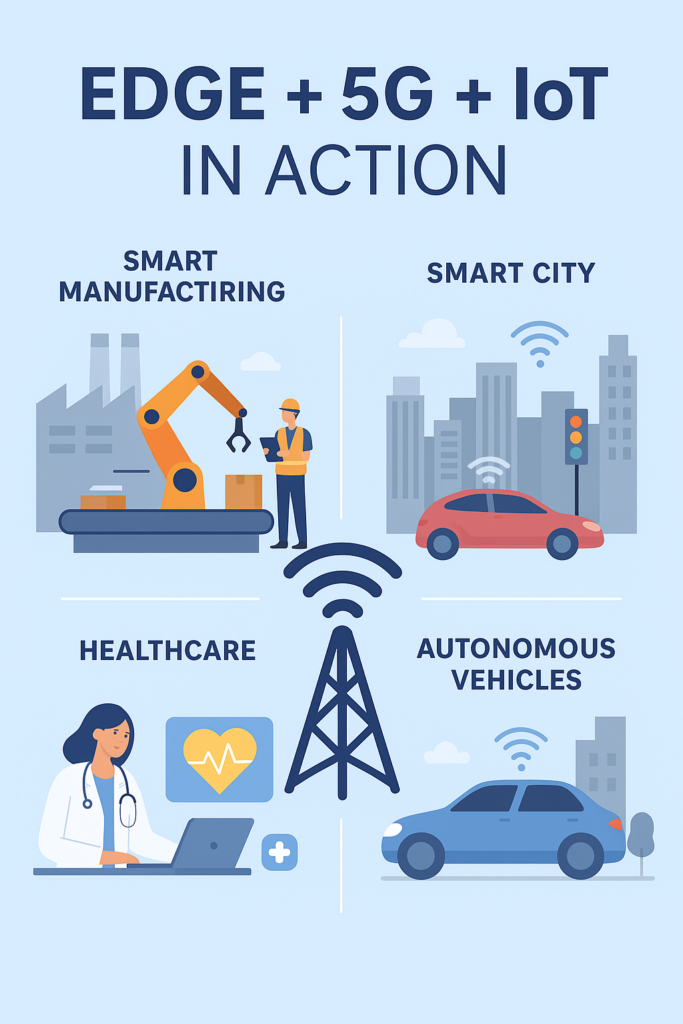Contents
Meta Description: Explore how Edge Computing, 5G, IoT, and Real-Time Connectivity are transforming industries by reducing latency, boosting resilience, and enabling smarter, faster digital systems worldwide.
What Is Edge Computing and Why Does It Matter?
Edge computing refers to processing data locally—at or near the source of generation—rather than transmitting everything to a centralized cloud. For example, an autonomous car cannot afford the milliseconds of delay that occur when sending sensor data to a distant data center. By analyzing data at the edge, decisions are made almost instantaneously, ensuring safety and efficiency.
Key benefits of edge computing include:
- Reduced latency: Decisions are faster because data doesn’t have to travel far.
- Resilience: Edge devices can operate even when disconnected from the cloud.
- Bandwidth optimization: Less data is sent across networks, reducing congestion.
- Enhanced privacy: Sensitive information can be processed locally without leaving the device or facility.
Learn more about Edge Computing from IBM.
The Role of 5G in Driving the Edge
If edge computing is the brain, 5G is the nervous system. The fifth-generation mobile network standard provides:
- Ultra-low latency (as little as 1 millisecond).
- High throughput for massive data transfer.
- Support for millions of devices per square kilometer—ideal for dense IoT ecosystems.
Together, edge computing and 5G enable scenarios where real-time responsiveness is non-negotiable, such as telesurgery, augmented reality (AR), and industrial automation.
Discover more about 5G capabilities on Qualcomm.
IoT: Billions of Devices Demanding Real-Time Action
The Internet of Things (IoT) is already enormous, with more than 15 billion connected devices worldwide in 2025, and projected to surpass 30 billion by 2030. Each device—from smart thermostats to jet engines—generates streams of data that can be analyzed for insights.
Traditionally, this deluge has strained cloud infrastructures. But with edge computing, IoT devices can process data locally, filter out noise, and send only essential information to the cloud. This architecture reduces lag, improves efficiency, and ensures systems remain reliable.
See IoT growth statistics on Statista.
Real-World Applications
1. Healthcare
Imagine a patient wearing a connected heart monitor. Instead of sending every heartbeat to a remote cloud server, the device processes signals locally, detecting abnormalities in real time. If it detects a dangerous arrhythmia, it can alert doctors instantly—potentially saving lives. Edge-enabled telesurgery is also becoming feasible, with surgeons remotely operating on patients using real-time robotic instruments powered by 5G.
2. Manufacturing
Factories are deploying IoT sensors to monitor machinery, predict failures, and optimize production lines. Edge computing allows immediate responses to anomalies, minimizing downtime and reducing maintenance costs. This “smart factory” model is already in use at companies like Siemens and Bosch.
3. Retail
Retailers are using edge-enabled cameras and sensors to analyze in-store traffic patterns, monitor shelves, and deliver personalized offers in real time. Combined with 5G, augmented reality shopping experiences—like virtual try-ons—are becoming mainstream.
4. Autonomous Vehicles
Perhaps the most compelling case for edge computing and 5G is in self-driving cars. Vehicles must process terabytes of sensor data per hour. Relying on distant cloud servers would be unsafe. Instead, cars analyze most data on-board, while 5G provides constant connectivity to traffic systems and other vehicles for coordination.
5. Smart Cities
Traffic lights, energy grids, and public safety systems are being equipped with IoT sensors. Edge computing ensures decisions—like rerouting vehicles during congestion or dispatching emergency services—are executed without delay.
Challenges Ahead
While the promise is vast, there are hurdles:
- Infrastructure investment: Building edge nodes, upgrading telecom towers, and deploying 5G networks is costly.
- Interoperability: With so many devices and standards, creating unified ecosystems is difficult.
- Security risks: Edge devices can be vulnerable entry points for cyberattacks.
- Skill gaps: Companies must train workers in new disciplines spanning AI, networking, and IoT integration.
Explore cybersecurity risks of IoT with McKinsey.
The Business Case
According to research from IDC, worldwide spending on edge computing is expected to surpass $250 billion annually by 2026. Telecom operators, cloud providers, and enterprises are investing heavily to stay competitive.
- Telecoms see edge + 5G as new revenue streams beyond traditional connectivity.
- Enterprises see faster ROI in automation, efficiency gains, and better customer experiences.
- Tech giants like Amazon, Microsoft, and Google are launching edge platforms integrated with their cloud services, offering “hybrid” models.
The Future of Real-Time Connectivity
Edge computing, 5G, and IoT form the foundation of real-time connectivity—a world where devices don’t just communicate but respond, adapt, and make decisions without human intervention. This evolution will:
- Transform supply chains into responsive ecosystems.
- Power immersive experiences in education, gaming, and healthcare.
- Create resilient, self-healing systems across industries.
As organizations race to digitize, those who harness edge and 5G will gain a clear competitive advantage. The winners will be the ones who treat real-time connectivity not as an upgrade but as the core infrastructure of the next digital revolution.

Internal Links
For related technology insights, see:
- Autonomous AI in Business
- Generative AI Everywhere
- Hyper-Automation & Integration
- Quantum Computing & Related Fields
- Extended Reality (XR)
Conclusion
The convergence of edge computing, 5G, IoT, and real-time connectivity is not just a technological shift—it’s a societal one. From smarter cities and safer vehicles to life-saving medical interventions, the possibilities are vast. But unlocking them requires overcoming challenges in infrastructure, security, and interoperability.
One thing is certain: in the digital economy of tomorrow, milliseconds matter. The edge is where the future is being built.



